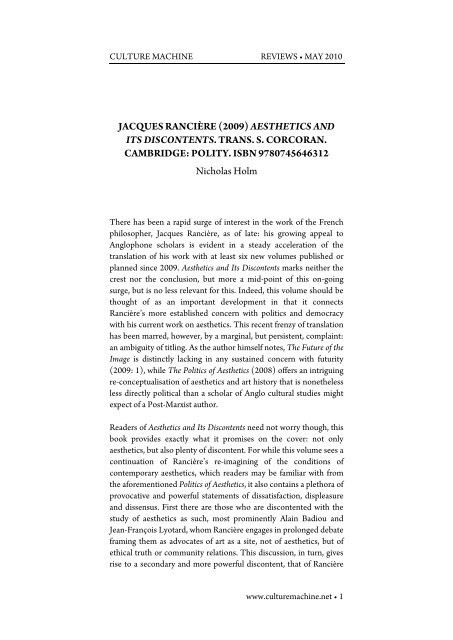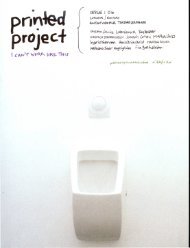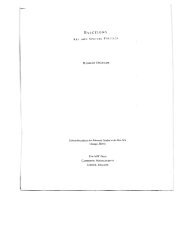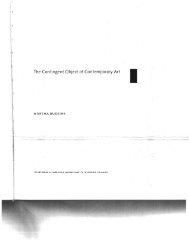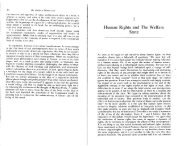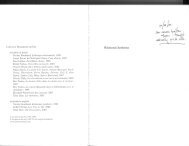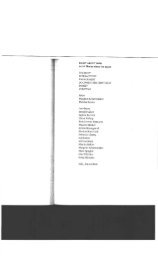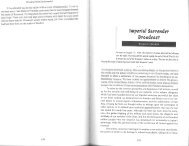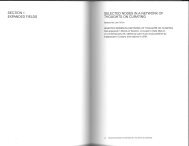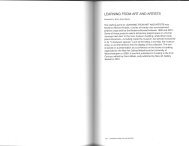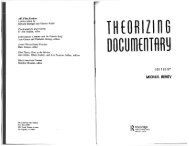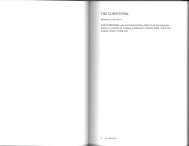Aesthetics and Its Discontents (2009) by Jacques Rancière
Aesthetics and Its Discontents (2009) by Jacques Rancière
Aesthetics and Its Discontents (2009) by Jacques Rancière
You also want an ePaper? Increase the reach of your titles
YUMPU automatically turns print PDFs into web optimized ePapers that Google loves.
CULTURE MACHINE REVIEWS • MAY 2010<br />
JACQUES RANCIÈRE (<strong>2009</strong>) AESTHETICS AND<br />
ITS DISCONTENTS. TRANS. S. CORCORAN.<br />
CAMBRIDGE: POLITY. ISBN 9780745646312<br />
Nicholas Holm<br />
There has been a rapid surge of interest in the work of the French<br />
philosopher, <strong>Jacques</strong> <strong>Rancière</strong>, as of late: his growing appeal to<br />
Anglophone scholars is evident in a steady acceleration of the<br />
translation of his work with at least six new volumes published or<br />
planned since <strong>2009</strong>. <strong>Aesthetics</strong> <strong>and</strong> <strong>Its</strong> <strong>Discontents</strong> marks neither the<br />
crest nor the conclusion, but more a mid-point of this on-going<br />
surge, but is no less relevant for this. Indeed, this volume should be<br />
thought of as an important development in that it connects<br />
<strong>Rancière</strong>’s more established concern with politics <strong>and</strong> democracy<br />
with his current work on aesthetics. This recent frenzy of translation<br />
has been marred, however, <strong>by</strong> a marginal, but persistent, complaint:<br />
an ambiguity of titling. As the author himself notes, The Future of the<br />
Image is distinctly lacking in any sustained concern with futurity<br />
(<strong>2009</strong>: 1), while The Politics of <strong>Aesthetics</strong> (2008) offers an intriguing<br />
re-conceptualisation of aesthetics <strong>and</strong> art history that is nonetheless<br />
less directly political than a scholar of Anglo cultural studies might<br />
expect of a Post-Marxist author.<br />
Readers of <strong>Aesthetics</strong> <strong>and</strong> <strong>Its</strong> <strong>Discontents</strong> need not worry though, this<br />
book provides exactly what it promises on the cover: not only<br />
aesthetics, but also plenty of discontent. For while this volume sees a<br />
continuation of <strong>Rancière</strong>’s re-imagining of the conditions of<br />
contemporary aesthetics, which readers may be familiar with from<br />
the aforementioned Politics of <strong>Aesthetics</strong>, it also contains a plethora of<br />
provocative <strong>and</strong> powerful statements of dissatisfaction, displeasure<br />
<strong>and</strong> dissensus. First there are those who are discontented with the<br />
study of aesthetics as such, most prominently Alain Badiou <strong>and</strong><br />
Jean-François Lyotard, whom <strong>Rancière</strong> engages in prolonged debate<br />
framing them as advocates of art as a site, not of aesthetics, but of<br />
ethical truth or community relations. This discussion, in turn, gives<br />
rise to a secondary <strong>and</strong> more powerful discontent, that of <strong>Rancière</strong><br />
www.culturemachine.net • 1
HOLM • AESTHETICS CM REVIEWS • 2010<br />
himself, who takes critical aim at what he describes as the ‘ethical<br />
turn’ of contemporary thinking in matters of both politics <strong>and</strong><br />
aesthetics, manifest in not only the aesthetic thought of Badiou <strong>and</strong><br />
Lyotard, but also that political theory that takes its lead from the<br />
work of Giorgio Agamben. In doing so, <strong>Rancière</strong> offers a cogent new<br />
theoretical framework through which to think the political<br />
possibilities, but also perennial problems, of critical art in the<br />
Modernist project, while bringing together the previously disparate<br />
str<strong>and</strong>s of his political <strong>and</strong> aesthetic thought in a new synthesis that<br />
exp<strong>and</strong>s upon the promise of his earlier work. If this appears as<br />
something of a return to old, or even out-dated, questions, it is<br />
because, for <strong>Rancière</strong>, those debates were never finished <strong>and</strong> the<br />
concerns <strong>and</strong> possibilities raised therein never adequately accounted<br />
for, which produces the current confusion <strong>and</strong> subsequent rejection<br />
of aesthetics.<br />
The line which the argument of <strong>Aesthetics</strong> <strong>and</strong> <strong>Its</strong> <strong>Discontents</strong><br />
develops is neither straight nor direct. As with other recent works of<br />
<strong>Rancière</strong>, this is a collection of talks, seminars <strong>and</strong> essays – five in<br />
total – delivered <strong>and</strong> published in different international venues<br />
between 1995 <strong>and</strong> 2004. While presented as a single whole, any<br />
cohesive <strong>and</strong> systematic overview is not simply provided, but instead<br />
must be inferred. Taken together, the introduction <strong>and</strong> opening<br />
section, ‘Politics of <strong>Aesthetics</strong>’, along with the final chapter, ‘The<br />
Ethical Turn of <strong>Aesthetics</strong> <strong>and</strong> Politics’, constitute a wide-ranging<br />
discussion of critical art, political aesthetics <strong>and</strong> the ethical turn,<br />
which acts to bookend specific dissections of Badiou <strong>and</strong> Lyotard,<br />
loosely grouped under the heading, ‘The Antimonies of<br />
Modernism’. Given this wide variation in its origins, the book is<br />
surprisingly coherent as a whole, but still suffers from a degree of<br />
ellipsis, on one h<strong>and</strong>, <strong>and</strong> repetition, on the other, both internally<br />
<strong>and</strong> with respect to <strong>Rancière</strong>’s other recent publications. The effect<br />
is less of a conversation interrupted mid-stream, than of a television<br />
serial whose comprehensibility depends on having viewed all the<br />
prior episodes: new viewers can still follow along with the main<br />
thrust of the action, <strong>and</strong> derive a great deal of pleasure <strong>and</strong><br />
enlightenment in doing so, but are liable to overlook finer details<br />
which appear full of meaning to the seasoned viewer. The exposition<br />
of earlier ideas central to the current work are summarised in<br />
passing, but, despite their inclusion, the readers who did not catch<br />
the previous instalment will be at a distinct disadvantage. This<br />
caveat should not ward off new readers – who will most likely gain as<br />
much as they lose <strong>by</strong> approaching the work with fresh eyes – but<br />
simply caution them that the glossary that accompanies the earlier<br />
www.culturemachine.net • 2
HOLM • AESTHETICS CM REVIEWS • 2010<br />
Politics of <strong>Aesthetics</strong>, which explains <strong>Rancière</strong>’s basic conceptual<br />
language, might serve as a useful companion. That said, in relation to<br />
that earlier work, with this iteration <strong>Rancière</strong> comes across a much<br />
more engaging <strong>and</strong> casual author, less prone to bombastic<br />
pronouncements couched in thickets of jargon <strong>and</strong> gr<strong>and</strong>iose<br />
elocutions. This is likely not an effect of a shift in writing style in the<br />
original, but of a more modest translation (of particular note is an<br />
idiosyncratic though quite endearing use of the word, ‘mate’ as a<br />
synonym for friend [112]) <strong>and</strong> this volume is the better for it.<br />
As the title clearly suggests, the first section addressing the ‘Politics<br />
of <strong>Aesthetics</strong>’ is a return to the subject matter of <strong>Rancière</strong>’s earlier<br />
work of the same name: a rewriting of art history, with an eye to the<br />
manner in which underst<strong>and</strong>ings of art relate to political,<br />
epistemological <strong>and</strong> social modes of being, what <strong>Rancière</strong> refers to<br />
as the ‘distribution of the sensible’ (25). More than a simple reprise,<br />
the first half of the book recalibrates <strong>and</strong> elaborates upon this<br />
theoretical construct in direct opposition to those who would<br />
denigrate the discourse of aesthetics, whether as an ideological<br />
illusion or an interruption between the spectator <strong>and</strong> the sensual<br />
power of pure art. And though <strong>Rancière</strong> suggests that the<br />
contemporary rejection of aesthetics has gone beyond the<br />
Distinction model of mystification (Bourdieu: 1984), anointing<br />
Badiou as Bourdieu’s successor in anti-aestheticism if not in method<br />
or in temperament, those in cultural studies might question the<br />
assertion that the moment of Bourdieu’s model has passed. If<br />
anything, we are more tightly wedded to that model, still, than to any<br />
interpretation arising out of the work of Badiou, where aesthetics is<br />
that which comes between the subject <strong>and</strong> the glorious encounter<br />
with art. Against both Badiou <strong>and</strong> Bourdieu, though, <strong>Rancière</strong><br />
suggests that the possibility that the discourse of aesthetics, <strong>and</strong> the<br />
apparent confusion therein is not an invention of speculative<br />
philosophers, but rather a response to a wider mutation in the<br />
cultural perception <strong>and</strong> function of art. This mutation is understood<br />
in terms of a shift from a ‘Representative’ to an ‘Aesthetic’ regime of<br />
art, which creates new profane conditions of art divorced from any<br />
apparent natural order. For those not familiar with his previous work<br />
on the succession of the regimes of art, <strong>Rancière</strong> builds his argument<br />
within a précis of that model, wherein he defines the movement<br />
from representative to aesthetic as a shift from an art caught up in<br />
socially m<strong>and</strong>ated hierarchies of subject <strong>and</strong> genre to a detached art<br />
of disorder, which seeks its justification in poetic models of human<br />
potential <strong>and</strong> affect. <strong>Rancière</strong> is at pains to make it clear that his<br />
intention here is not to defend such a regime, or the political claims<br />
www.culturemachine.net • 3
HOLM • AESTHETICS CM REVIEWS • 2010<br />
it might make, but rather to clarify <strong>and</strong> make sense of the manner in<br />
which aesthetics has been thought to carry the promise of a politics<br />
within itself. As <strong>Rancière</strong> himself admits, this argument is somewhat<br />
complicated <strong>by</strong> the double-duty of the term ‘aesthetics’, which here<br />
works as both ‘a general regime of the visibility <strong>and</strong> intelligibility of<br />
art <strong>and</strong> a mode of interpretive discourse that itself belongs to this<br />
regime’ (11): in the face of this ambiguity the reader is left to<br />
distinguish between these two usages; a task that is not perhaps as<br />
straightforward as the author suggests.<br />
Thus, while it is the second definition that informs <strong>Rancière</strong>’s<br />
declaration of a shift from a representative to an aesthetic regime, it<br />
is the first that informs his notion of the “distribution of the<br />
sensible,” the set of self-evident facts of a community as to what or<br />
who may be seen, heard <strong>and</strong> known. Previously considered in chiefly<br />
aesthetic terms, this fundamental notion of the “sensible” is here<br />
exp<strong>and</strong>ed upon to encompass its political sense, which in previous<br />
works has been only hinted at rather than fully developed. Here,<br />
then, is the expression of <strong>Rancière</strong>’s wider <strong>and</strong> on-going project: an<br />
articulation between the aesthetic concerns of The Politics of<br />
<strong>Aesthetics</strong> (2008) on one h<strong>and</strong>, <strong>and</strong> the political apparatus of his<br />
earlier works, such as Disagreement (1999) or the more recent<br />
Hatred of Democracy (2006), on the other. In this formulation,<br />
politics is thought to constitute a process of rendering visible <strong>and</strong><br />
audible of those previously understood to be outside the community<br />
or to lack the capacity for political speech, such that their dem<strong>and</strong>s<br />
disrupt situations of consensus <strong>and</strong> dem<strong>and</strong> a space for those groups<br />
within the community. Both politics <strong>and</strong> aesthetics are thus taken up<br />
as moments of the distribution of the sensible: interventions into the<br />
sensory coordinates of the status quo which effect a redistribution<br />
<strong>and</strong> reapportioning of identities, subjects, spaces <strong>and</strong> times, which is<br />
to say ‘different ways of relating the constitution of a material form<br />
<strong>and</strong> that of a symbolic space’ (25).<br />
The politics of aesthetics are thus tied to the potential of art to<br />
disrupt stable forms of sensory community experience, a potential<br />
that <strong>Rancière</strong> theorises in terms of two distinct <strong>and</strong> opposing forces<br />
within the artistic practices of Modernity: the absolute separation of<br />
art from the everyday <strong>and</strong> the promise of art to rebuild the<br />
community. Both these forces are argued to be anchored in the<br />
purported autonomy of Modernist art, which <strong>Rancière</strong><br />
conceptualises through the somewhat unorthodox evocation of<br />
Friedrich von Schiller <strong>and</strong> his notion of art <strong>and</strong> aesthetics as a selfcontained<br />
site of ‘free appearance’ <strong>and</strong> ‘free play’ (27). Schiller’s<br />
www.culturemachine.net • 4
HOLM • AESTHETICS CM REVIEWS • 2010<br />
freedom of art is presented as an exemplary articulation of the<br />
aesthetic regime, wherein art promises an alternative to the ordinary<br />
everyday sensorium of unfree work <strong>and</strong> domination. The aesthetic<br />
there<strong>by</strong> promises the possibility of a sensory revolution, couched in<br />
unfashionably Utopian <strong>and</strong> even Idealist terms, as more profound<br />
than any revolution at the level of the state: an aesthetic revolution<br />
which ‘appears as the germ of a new humanity, of a new form of<br />
individual <strong>and</strong> collective life’ (32). It is <strong>by</strong> dint of its separation that<br />
art under the aesthetic regime produces its particular politics, or<br />
‘metapolitics’, as <strong>Rancière</strong> corrects himself (in the <strong>Rancière</strong>an<br />
lexicon, metapolitics refers to a political philosophy which perceives<br />
a greater political truth beneath or beyond the false conflicts of<br />
democratic politics, of which he cites Marxism as an example).<br />
There is thus no contradiction between the purity of art for art’s sake<br />
<strong>and</strong> the politicisation of art, but rather a deeper paradox which arises<br />
in the mode of aesthetic art itself, between the separation of<br />
autonomous art <strong>and</strong> its promise to transform the world: ‘The work’s<br />
solitude carries a promise of emancipation. But the fulfillment of<br />
that promise amounts to the elimination of art as a separate reality’<br />
(36).<br />
The politics of art under an aesthetic regime may thus be<br />
conceptualised through two conflicting interpretations: those of the<br />
‘resistant form’ <strong>and</strong> those of the ‘becoming-life of art’ (44). It is in<br />
terms of this conflict that <strong>Rancière</strong> seeks to explain <strong>and</strong> account for<br />
the political possibilities of a contemporary critical art: one which<br />
seeks to produce critical knowledge of the structures of domination<br />
in its spectator. However, with the end of the avant-garde <strong>and</strong> the<br />
emergence of what <strong>Rancière</strong> refers to as the ‘post-Utopian<br />
aesthetics’ of contemporary art, he suggests that these contradictory<br />
forces have become prised apart into an aesthetics of the sublime, on<br />
one h<strong>and</strong>, <strong>and</strong> ‘relational aesthetics’ on the other. The latter seeks to<br />
use art to actively <strong>and</strong> directly rebuild sundered community bonds,<br />
while the former perceives art as a site of ‘dazzling, heterogeneous<br />
singularity ... that comm<strong>and</strong>s a sense of community’ beyond political<br />
emancipation (21). Both share in common, though, a desire to<br />
construct a new community, or world space, through art. These are<br />
no longer critical arts per se, then, but rather transformations of art<br />
from dialectic provocations to heterogeneous compositions, which<br />
<strong>Rancière</strong> classifies in terms of four major ‘figures’: the play, the<br />
inventory, the encounter <strong>and</strong> the mystery (53). The compounding<br />
paradox here is that these new forms of art <strong>and</strong> artist are increasingly<br />
called upon to perform political functions, a task to which <strong>Rancière</strong><br />
expresses considerable doubt as to their adequacy. Certainly, the<br />
www.culturemachine.net • 5
HOLM • AESTHETICS CM REVIEWS • 2010<br />
framework that he furnishes for thinking through the political role of<br />
such art would seem to suggest a pessimistic interpretation of art’s<br />
place in any democratic politics that could potentially be construed<br />
<strong>by</strong> members of the art community, where <strong>Rancière</strong> has apparently<br />
enjoyed considerable popularity (Davis, 2006), as a betrayal<br />
tantamount to that of Jean Baudrillard’s 1996 essay ‘The Conspiracy<br />
of Art’ (2005).<br />
Rather than follow up this question of political art in any great detail,<br />
however, <strong>Rancière</strong> turns to a more in-depth consideration of the<br />
titular discontents, Badiou <strong>and</strong> Lyotard. While certainly present in<br />
the earlier stage of <strong>Rancière</strong>’s discussion, these two theorists here<br />
take centre stage as the subjects of extended critiques of their<br />
particular (in)aesthetic models. For those not concerned with the<br />
vagaries or specificities of continental philosophical debates, these<br />
middle sections will most likely prove the least compelling or useful,<br />
in particular the oddly pedantic denunciation of Badiou’s inaesthetic<br />
model, published in English as The H<strong>and</strong>book of Inaesthetics (2004),<br />
which requires that the reader have some prior acquaintance with<br />
that text. <strong>Rancière</strong>’s critique of Badiou is largely premised upon a<br />
restatement of <strong>Rancière</strong>’s own model of artistic transition between<br />
ethical, representative <strong>and</strong> aesthetic regimes in opposition to<br />
Badiou’s own schema, yet in the absence of a wider theoretical<br />
context this denunciation reads as more of a contradiction than an<br />
argument, another episode in an on-going feud between two former<br />
students of Althusser. In contrast, <strong>Rancière</strong>’s treatment of Lyotard,<br />
which focuses upon The Inhuman (1991), is much more<br />
immediately accessible <strong>and</strong> compelling in its range <strong>and</strong> reach. The<br />
critique of Lyotard’s theory of sublime aesthetics is rooted in a<br />
reminder, reinterpretation <strong>and</strong> reinterpretation of that model’s<br />
Kantian foundations: indeed Lyotard’s sublime is presented as a<br />
complete inversion of its Kantian counterpart. <strong>Rancière</strong> is careful to<br />
characterise this as an intentional, rather than accidental, divergence,<br />
motivated <strong>by</strong> a desire to retain art as a category radically <strong>and</strong> sensibly<br />
distinct from everyday objects of consumption. This separation,<br />
<strong>Rancière</strong> suggests, allows a conception of art as a site of ultimate<br />
separation <strong>and</strong> ultimate strangeness that is irreconcilably alienated<br />
from the experience of reason, <strong>and</strong> that there<strong>by</strong> functions as the site<br />
of the ethical commitment to the Other. Rather than a promise of<br />
resistance, art then becomes an obligation to remember, which<br />
<strong>Rancière</strong> defines as ‘ethics, [which] accomplishes a joint suppression<br />
of both aesthetics <strong>and</strong> politics’ (105).<br />
www.culturemachine.net • 6
HOLM • AESTHETICS CM REVIEWS • 2010<br />
It is to this question <strong>and</strong> concern of ethics that <strong>Rancière</strong> turns in the<br />
final chapter. Admitting that “ethics is no doubt a fashionable word,”<br />
<strong>Rancière</strong> goes on to argue that any obvious underst<strong>and</strong>ing of this<br />
current moment as ethical is mistaken, <strong>and</strong> that what he refers to as<br />
‘the reign of ethics is not the reign of moral judgement over the<br />
operations of art or of political action’ (109). Rather, <strong>Rancière</strong><br />
proffers an alternate underst<strong>and</strong>ing of ethics as the ‘subsumption of<br />
all forms of discourse <strong>and</strong> practice beneath the same indistinct point<br />
of view’ (110). The ethical experience of the world entails a radical<br />
interpretation of law, now understood as fact, to which all <strong>and</strong><br />
everything must comply: a state of affairs which gives rise to an<br />
‘unprecedented dramaturgy of infinite evil, justice <strong>and</strong> reparation’<br />
(110) that is argued to inform in equal measure Lars von Trier’s<br />
Dogville, Clint Eastwood’s Mystic River, the War on Terror <strong>and</strong><br />
Agamben’s political theory of the exception <strong>and</strong> the camp.<br />
Following the ethical turn, there is a suppression of the division<br />
between law <strong>and</strong> fact in order to establish ‘consensus’, which for<br />
<strong>Rancière</strong> is equivalent to the evacuation of the political core of the<br />
community. In seeking to reduce conflict, consensus suppresses<br />
differences within a community, assigning every person a correct<br />
place within the consequent social order. Those left outside no<br />
longer constitute supplementary political subjects with rights that<br />
just have not yet been acknowledged, <strong>and</strong> whom the community is<br />
obligated to assist, but rather radical <strong>and</strong> alien others who are<br />
subject to absolute rejection from the community <strong>and</strong> the attendant<br />
rights. Under such conditions, all differences <strong>and</strong> distinctions are<br />
levelled out in their ethical confrontation with the ‘law of the Other’<br />
(119). And though this language arises out of Lyotard, it is in<br />
Agamben’s theory of the state of exception, in books such as<br />
Remnants of Auschwitz (1999) <strong>and</strong> State of Exception (2005) that<br />
<strong>Rancière</strong> locates the most pertinent expression of the ethical.<br />
<strong>Rancière</strong> argues that Agamben’s generalisation of the state of<br />
exception functions to erase all differences ‘between henchmen <strong>and</strong><br />
victims, including even that between the extreme crime of the Nazi<br />
State <strong>and</strong> the ordinary everyday life of our democracies’ (120).<br />
Under the global law of exception, the possibility of difference,<br />
dissensus <strong>and</strong> politics evaporate before an indistinct ethical regime,<br />
wherein the only possibility of salvation arises from a messianic<br />
waiting. In <strong>Rancière</strong>’s terminology, the state of exception thus<br />
constitutes an ‘archipolitics’, the relegation of the entire community<br />
in the face of an absolute ethical edict, ‘in which all forms of<br />
domination, or of emancipation, are reduced to the global nature of<br />
an ontological catastrophe from which only a God can save us’ (43).<br />
www.culturemachine.net • 7
HOLM • AESTHETICS CM REVIEWS • 2010<br />
Nor is this ethical closure restricted to politics; <strong>Rancière</strong> locates an<br />
aesthetic analogy in the previously considered notion of the sublime,<br />
which provides him an opportunity to return one last time to his<br />
interlocutor of choice, Lyotard. The art of the sublime is an art of<br />
indirect consensus, <strong>Rancière</strong> declares, insofar as it is an art of the<br />
unrepresentable, which for Lyotard arises out of the ‘endless evil <strong>and</strong><br />
catastrophe’ that arises out of the suffering of the Holocaust (123).<br />
The unrepresentable is the central term of the ethical turn of<br />
aesthetics, not simply because the notion conceals an ethical<br />
proscription, but because that proscription collapses aesthetic <strong>and</strong><br />
moral autonomy into a singular law of alienation that arises from<br />
outside art. Art’s promise of emancipation or political radicality is<br />
thus transformed into its inversion: an endless work of mourning<br />
<strong>and</strong> ‘ethical witnessing of unrepresentable catastrophe’ (131), not of<br />
the revolution to come, but now instead of the radical unthinkable<br />
event of the Holocaust. This ‘hard ethics of infinite evil’ finds its<br />
compliment in the ‘soft ethics of consensus’ of relational aesthetics,<br />
which <strong>Rancière</strong> finds equally culpable in the establishment of an<br />
ethical order due to such art’s attempts to repair the social bond <strong>and</strong><br />
foster consensus. Thus the previous promise of art to generate<br />
political <strong>and</strong> aesthetic change now gives way to a legitimation of a<br />
single consensual order.<br />
What then are we to make of the possibility of a progressive political<br />
aesthetics in light of <strong>Rancière</strong>’s dissection of the conditions of<br />
contemporary possibility? Left unanswered is the question of<br />
whether aesthetic operations constitute a proper politics in any<br />
sense, or whether aesthetics is simply understood as another<br />
manifestation of what <strong>Rancière</strong> elsewhere designates ‘political<br />
philosophy’ that distracts from a democratic political programme.<br />
We are left in little doubt, though, that an aesthetic metapolitics is<br />
always preferable to an ethical archipolitics. The practice of art<br />
under an aesthetic regime is certainly linked to the production of a<br />
democratic dissensus, but its designation as metapolitical leaves a<br />
final conclusion unforthcoming <strong>and</strong> open to interpretation,<br />
especially given <strong>Rancière</strong>’s turn to Marxism as the example par<br />
excellence of metapolitics. Is <strong>Rancière</strong> here then positing aesthetics<br />
as comparable to Marxism in its political programme <strong>and</strong> scope?<br />
Could such a declaration be considered a new theory of political<br />
aesthetics or instead simply recuperated within those historical<br />
categories, such as Romanticism or Idealism, with which<br />
contemporary theory has all but dispensed? While there is a<br />
possibility that some readers may take issue with the extent of<br />
<strong>Rancière</strong>’s claims for art as a political force, there are certainly no<br />
www.culturemachine.net • 8
HOLM • AESTHETICS CM REVIEWS • 2010<br />
grounds on which <strong>Aesthetics</strong> <strong>and</strong> its <strong>Discontents</strong> could be considered<br />
to do so naively. Rather, this volume comprises the transition of<br />
<strong>Rancière</strong>’s theory of art into a well-situated <strong>and</strong> widely-informed<br />
assault on a current critical orthodoxy of ethical thought that itself<br />
exhibits a theoretical variant of ‘consensus’ of the sort that <strong>Rancière</strong><br />
seeks to critique. Indeed, this is perhaps the most productive, albeit<br />
the most generous, manner in which to interpret <strong>Rancière</strong>’s<br />
declaration of discontent: as an admonition to recall the political<br />
potential once perceived within the aesthetic <strong>and</strong> to there<strong>by</strong> take<br />
stock of how that might challenge an increasing sense of ethical<br />
consensus in art, politics <strong>and</strong> critical theory, as well as the ways in<br />
which we think through them.<br />
References<br />
Agamben, G. (1999) Remnants of Auschwitz. Trans. D Heller-<br />
Roazen. New York: Zone Books.<br />
Agamben, G. (2005) State of Exception. Trans. K. Attell. Chicago:<br />
University of Chicago Press.<br />
Badiou, A. (2005) The H<strong>and</strong>book of Inaesthetics. Trans. A. Toscano.<br />
Stanford: Stanford University Press.<br />
Baudrillard, J. (2005) The Conspiracy of Art. Trans. A. Hodge. New<br />
York: Semiotext(e).<br />
Bourdieu, P. (1984) Distinction. Trans. R. Nice. Cambridge:<br />
Harvard University Press.<br />
Davis, B. (2006) “Ranciere, for Dummies”, ArtNet<br />
.<br />
Lyotard, J. (1991) The Inhuman. Trans. G. Bennington & R.<br />
Bowl<strong>by</strong>. Stanford: Stanford University Press.<br />
<strong>Rancière</strong>, J. (1999) Disagreement. Trans. J. Rose. Minneapolis:<br />
University of Minnesota Press.<br />
<strong>Rancière</strong>, J. (<strong>2009</strong>) The Future of the Image. Trans. G. Elliott.<br />
London: Verso.<br />
www.culturemachine.net • 9
HOLM • AESTHETICS CM REVIEWS • 2010<br />
<strong>Rancière</strong>, J. (2006) Hatred of Democracy. Trans. S. Corcoran. New<br />
York: Verso.<br />
<strong>Rancière</strong>, J. (2008) The Politics of <strong>Aesthetics</strong>. Trans. G. Rockhill. New<br />
York: Continuum.<br />
www.culturemachine.net • 10


